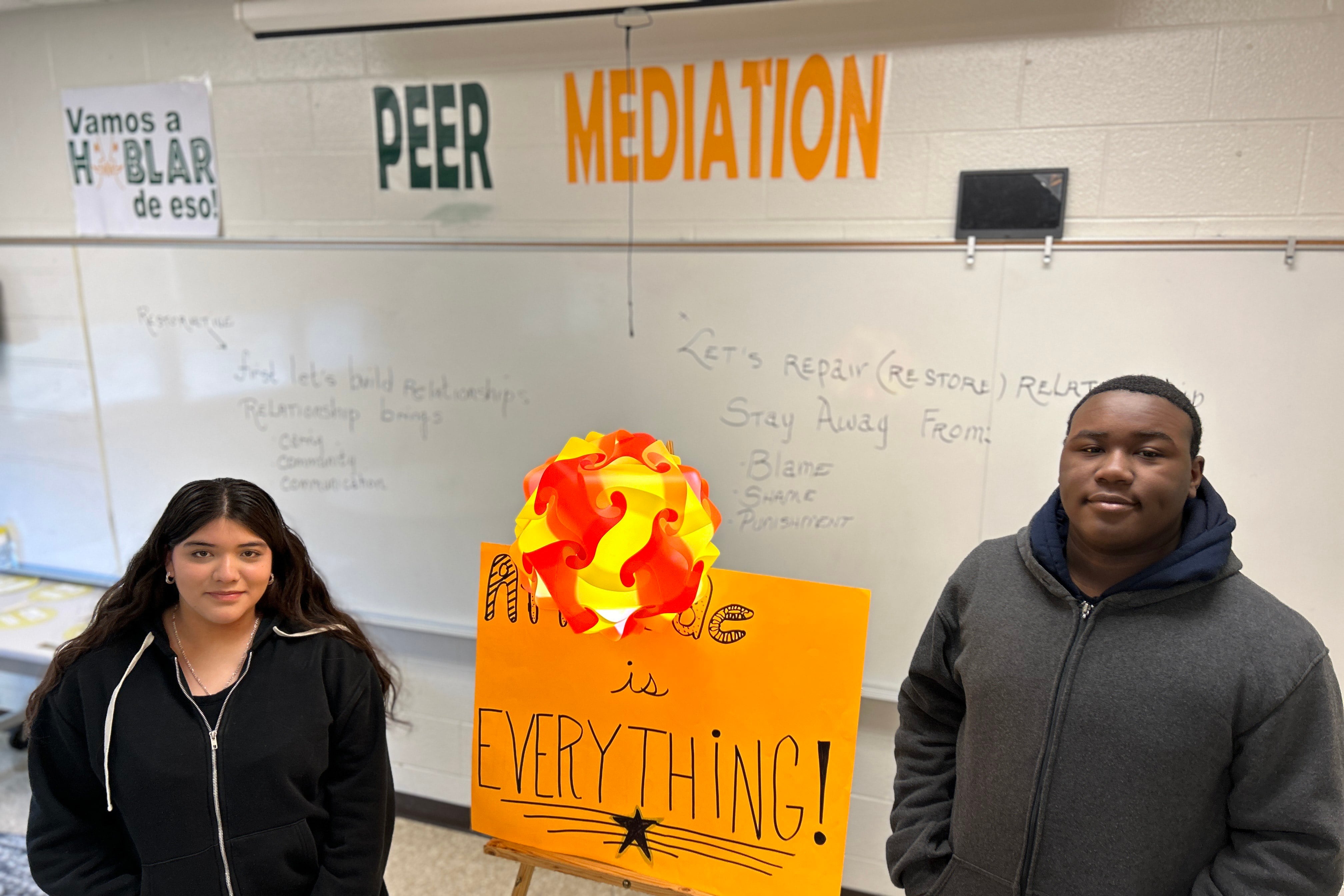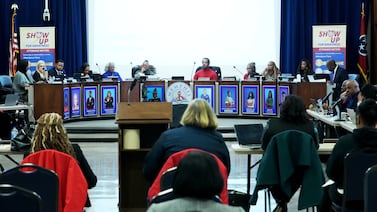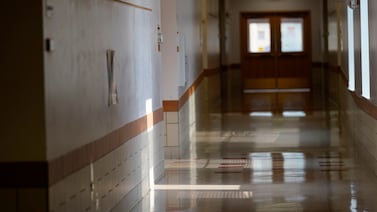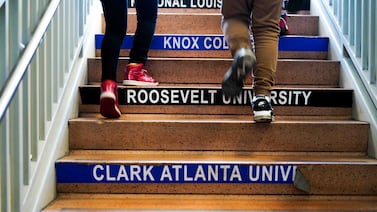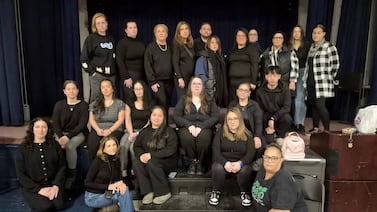Sign up for Chalkbeat Indiana’s free daily newsletter to keep up with Indianapolis Public Schools, Marion County’s township districts, and statewide education news.
When eighth grader Kelsey Aguilar is called from class to de-escalate a conflict between her peers, she heads to the Guided Learning Center at Harshman Middle School with a calm demeanor.
That’s where she’ll get to the heart of an issue between friends or couples, unpacking insults on social media or rumors that could lead to a fight.
The mediation program that Aguilar participates in as a peer mediator is part of the school’s restorative justice approach to discipline. It’s less punitive, aims to stop fights before they start, and focuses on healing transgressions between students.
It’s a disciplinary approach that Indianapolis Public Schools hopes to embrace district-wide through the adoption of a series of policies that aim to promote equity and reduce barriers to learning that affect certain groups of students. The policies, which the school board has been approving in batches, include a shift in how teachers should approach assigning homework and how the district should identify students for its gifted program. The board approved the latest round of policy changes — including one highlighting restorative justice in student discipline — on Tuesday.
The policies could address some of the district’s disparities that are common in education.
For example, Black and multiracial students in the district have historically been disciplined at higher rates than their white peers, according to district data. Some of the district’s most popular schools with specialized academic programming are disproportionately white.
And while the latest ILEARN state test scores show white students appear to have recovered from pandemic learning loss, Black and Hispanic students have yet to recover to pre-pandemic levels of proficiency.
At Harshman, officials say the mediation program has helped reduce the number of suspensions both for Black students and for students overall.
And Kelsey believes it has definitely reduced the number of fights among her peers — even though some may see mediation by a classmate as a joke.
“I honestly think it’s a serious thing because we’re solving problems with other people,” she said. “I think that’s a great thing for us to do.”
Changes to dress code, homework assignments adopted
The policy changes were proposed by the Culturally Responsive and Equitable Education Committee, which the school board created last year. They reflect much of the district’s ongoing work around expanding academic opportunities to more students of color and those from diverse backgrounds.
The district’s Rebuilding Stronger plan, for example, will bring Honors Algebra, Honors Geometry, Honors Biology, and Spanish I classes to all middle schools. The plan will also expand Montessori, STEM, high-ability, dual language, performing arts, and International Baccalaureate academic models to more schools throughout the district.
Many of the committee’s proposed changes codify the district’s current equity efforts under Superintendent Aleesia Johnson, said school board member Nicole Carey, who led the creation of the committee. But the policy shifts will hold any future leaders of the district accountable to this equity mindset, she said.
Here are equity-focused policies that the board approved in April:
- The district’s revised homework policy acknowledges that students come from “diverse backgrounds with different resources and support systems.” The policy says that, “Homework assignments must be equitable and considerate of these varied home environments.” In addition, the policy states that the assignments should also consider students’ academic needs and out-of-school responsibilities.
- The district’s revised policy on its gifted and talented program commits the district to using culturally responsive, unbiased assessments to identify students eligible for its academically gifted program. That program is currently housed at the K-8 Sidener Academy but will expand to two separate elementary and middle schools in 2024-25. It also directs the district to actively inform families from diverse backgrounds about the gifted program. (Enrollment data from 2023-24 shows Sidener Academy is whiter and has fewer students qualifying for free or reduced-price meals than the district as a whole.)
- The district’s new universal dress code provides less-rigid guidelines that aim to reduce disciplinary actions that keep students out of classrooms.
Below are some equity-focused policy changes the board approved Tuesday:
- The revised policy on the use of seclusion and restraint requires all administrators, special education teachers, and school-based crisis teams to undergo training in de-escalation techniques and conflict resolution strategies. All incidents involving seclusion or restraint of a student must be documented and provided to the student’s guardian in a timely manner, and an annual report of these incidents will be presented to the board.
- Another revised policy directs administration to develop clear, written criteria for the approval of student groups. It also encourages groups that represent diverse demographics and interests.
In March, the equity committee proposed a more comprehensive restorative justice policy that would require training for all staff members. But it’s unclear if that will come before the board.
Restorative justice at Harshman could be inspiration for others
Meanwhile, the new discipline policy says restorative justice approaches should be used as alternatives to traditional discipline “when appropriate.” It also says educators should collaborate with families on approaches to discipline.
At Harshman Middle School, officials say their mediation program has reduced the number of incidents of aggression or physical fighting between current eighth graders from the first semester of last year to the first semester of this year.
Sometimes, peer mediators such as Kelsey are called to oversee a mediation session with staff present. Other times, staff mediate. There are even sessions to resolve conflicts between staff and students.
Even the school’s hallways advertise restorative justice.
“Problem: Unresolved conflict,” reads one sign. “Solution: Peer mediation. Let’s talk about it!”
The school received support from the Peace Learning Center, funded through a grant, to provide mediation training for students and staff. Students are selected as mediators after an interview process.
School staff say the program has created a mindset shift in students, who will alert staff members of potential rising tensions between students or request mediation on their own.
“They don’t want to fight each other, they don’t want to argue, they don’t want to miss class, they don’t want to be suspended,” said Rockeyah Lord, a dean at the school.
Because the program aims to resolve issues before they devolve into fights, Lord said, suspensions overall have decreased.
Kelsey said she got involved in the program because she used to be involved in a lot of drama herself — but at times wanted a way to get out of it.
“I knew that other people do want to get out of it too sometimes,” she said. “So it’s better to talk about it than to keep going with it.”
Amelia Pak-Harvey covers Indianapolis and Lawrence Township schools for Chalkbeat Indiana. Contact Amelia at apak-harvey@chalkbeat.org.

